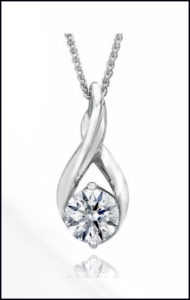Re-Engineering Retail
Author and internationally renowned consumer futurist, Doug Stephens, paints a bold vision of the future where every aspect of the retail experience, as we know it will be radically transformed.
 Stephens, AKA “The Retail Prophet”, gave the keynote presentation at the annual Plumb Club Breakfast symposium during JCK Las Vegas in June, co-sponsored by the Diamond Producers Association.
Stephens, AKA “The Retail Prophet”, gave the keynote presentation at the annual Plumb Club Breakfast symposium during JCK Las Vegas in June, co-sponsored by the Diamond Producers Association.
Sharing findings from his latest book, “Re-engineering Retail: The Future of Selling in a Post-Digital World”, Stephens addressed how the concept of what stores are, how consumers shop them, and the core economic model for revenue are being reinvented.
Since the release of his first book, the “Retail Revival”, change in the global retail sector has accelerated beyond even the boldest forecasts. Online giants in the U.S. like Amazon, Alibaba and eBay are growing at a dizzying pace, representing more than 40% of the global ecommerce market, totaling $2.3 trillion last year.
In 2017, 8,642 brick and mortar stores closed their doors in North America. Brands and retailers across categories are struggling to understand the shifting needs, expectations and behaviors of a new consumer.
But Stephens is optimistic. He cited that for more than 200 years, the retail experience has changed very little, noting that technological advances throughout our history have not drastically altered how we buy and sell like the Internet and digital technology have in the past decade.
So, it’s not surprising that retail is on the precipice of an historic reinvention that Stephens believes will leave both digital and physical retail barely recognizable to what we see today. “Even the centuries-old formula through which retail companies make money, the core economic model, is going to be shape-shifted beyond recognition and with it, the concept of what a store is.”
Store is Media
Stephens described physical retail stores transitioning from being primarily a distribution channel for products to becoming a powerful media channel for branded experiences and stories. It’s a transition that will change everything, including how retailers generate revenue.
“Save for a few particular kinds of products, we will have absolutely no need to visit physical stores simply to look at products, as we do today,” he said. “Instead, the physical shopping space will become a medium to distribute the most powerful, joyful and emotionally galvanizing experiences possible.”
These physical media experiences, said Stephens, will convey clear brand stories through physical engagement and multiple sensory inputs; offer opportunities for immersive and kinetic product experiences; and act as the interactive gateway to the entire brand ecosystem of products, services and purchase alternatives. “The goal of the store will be to create experiences so powerful that they catalyze sales across all available purchase points.”
Two-Tier Market
Where today’s retail market is largely divided by luxury, mid-tier and discount, the coming decade will see the market split into two camps. “The first will encompass a swelling number of vertically-integrated brands that focus on serving consumers at scale and in a way that best befits the brand,” said Stephens. “The second will be a new class of experiential merchants that use their stores and online assets to perfect the consumer experience across a category or categories of products. They will employ expert product ambassadors and technology to deliver customer experiences that are unique and memorable.”
 Unlike stores of today that are focused on four-wall sales, stores of the future will position themselves as true any-channel hubs, said Stephens. “They will serve customers through multiple means of fulfillment that will include their own channels, as well as direct-to-consumer sales from their brand partners. Attribution for these sales will matter less than delivering the powerful shopping experience responsible for generating them.”
Unlike stores of today that are focused on four-wall sales, stores of the future will position themselves as true any-channel hubs, said Stephens. “They will serve customers through multiple means of fulfillment that will include their own channels, as well as direct-to-consumer sales from their brand partners. Attribution for these sales will matter less than delivering the powerful shopping experience responsible for generating them.”
Stephens sees retailers in an untenable position when the brands they call vendors are also their competitors by going direct to consumers. He sees private label only partially remedying the situation. “The economic model for retail must be reimaged,” he said, advocating jewelers become experiential merchants in their stores, creative masters of retail stagecraft, and experts at executing consumer experiences. “Don’t build stores, build stories. Think productions, not products. You’re selling experiences that involve your products.”
Building Partnerships
Companies in The Plumb Club are bullish on partnerships with retailers for shared success, providing services, products, and programs that can help them create experiences for their customers. Brands like Shah Luxury, New York continues to expand its customization program to help jewelers deliver personalized services—altering existing styles and creating new designs.

“Vendor-retail partnerships are more important than ever,” believes Alok Mehta, CEO of IDD, New York. Creating collections that tell a story (i.e. Y.O.U., Harmony, Foreverday, 2BeLOVED), IDD offers a suite of support services like trunk shows, display and packaging, and marketing collateral to help retailers create unique experiences.
Rebecca Foerster for Leo Schachter Diamonds, New York encourages jewelers not to reinvent the wheel, but rather use resources provided by groups like the Diamond Producers Association, Diamond Empowerment, and Responsible Jewelers Association in training, talking points, and best practices. Storytelling is key, she notes, citing LSD’s Kalahari Dream collection as an example. Part of diamond community initiatives in Botswana, Namibia and South Africa where the stones derive, the collection promotes how diamonds uplift a community, with production funding hospitals, schools, clean drinking water, and more. The brand provides display, brochures, branded and GIA certificates, look-book with humanitarian/environmental stories, social media strategy, and retailer locator.










